
Warmbloods are a group of middle-weight horse types and breeds primarily originating in Europe and registered with organizations that are characterized by open studbook policy, studbook selection, and the aim of breeding for equestrian sport. The term distinguishes these horses from both heavy draft horses and refined light saddle horses such as the Thoroughbred, Arabian, and Akhal-Teke. Although modern warmbloods are descended from heavier agricultural types systematically upgraded by hotblood influence, the term does not imply that warmbloods are direct crosses of "cold" and "hot".

The Standardbred is an American horse breed best known for its ability in harness racing, where members of the breed compete at either a trot or pace. Developed in North America, the Standardbred is recognized worldwide, and the breed can trace its bloodlines to 18th-century England. They are solid, well-built horses with good dispositions. In addition to harness racing, the Standardbred is used for a variety of equestrian activities, including horse shows and pleasure riding, particularly in the Midwestern and Eastern United States and in Southern Ontario.

The Groninger or Groningen is a Dutch horse breed developed for light draft and agricultural work. It is closely related to heavy warmblood breeds like the East Friesian and Alt-Oldenburger. The breed was nearly lost in the mid-20th century because a significant number of mares were used for crossbreeding to create the Dutch Warmblood, leaving few purebreds.

The Friesian is a horse breed originating in Friesland in north Netherlands. The breed nearly became extinct on more than one occasion. It is classified as a light draught horse, and the modern day Friesian horse is used for riding and driving. The Friesian horse is most known for its all-black coat colour, its long flowing mane and tail, feathering on its legs, a high head carriage, and high stepping action.

The Morgan horse is one of the earliest horse breeds developed in the United States. Tracing back to the foundation sire Figure, later named Justin Morgan after his best-known owner, as well as mares of the now-extinct Narragansett Pacer breed, Morgans served many roles in 19th-century American history, being used as coach horses and for harness racing, as general riding animals, and as cavalry horses during the American Civil War on both sides of the conflict. Morgans have influenced other major American breeds, including the American Quarter Horse, the American Saddlebred, the Tennessee Walking Horse, and the Standardbred.

The American Saddlebred is a horse breed from the United States. This breed is referred to as the "Horse America Made". Descended from riding-type horses bred at the time of the American Revolution, the American Saddlebred includes the Narragansett Pacer, Canadian Pacer, Morgan and Thoroughbred among its ancestors. Developed into its modern type in Kentucky, it was once known as the "Kentucky Saddler" and used extensively as an officer's mount in the American Civil War. In 1891, a breed registry was formed in the United States. Throughout the 20th century, the breed's popularity continued to grow in the United States, and exports began to South Africa and Great Britain. Since the formation of the US registry, almost 250,000 American Saddlebreds have been registered and can now be found around the world, with separate breed registries established in Great Britain, Australia, continental Europe, and southern Africa.
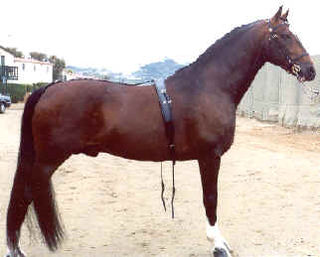
The Hackney is a recognized breed of horse that was developed in Great Britain. In recent decades, the breeding of the Hackney has been directed toward producing horses that are ideal for carriage driving. They are an elegant high stepping breed of carriage horse that is popular for showing in harness events. Hackneys possess good stamina, and are capable of trotting at high speed for extended periods of time.

The Oldenburg or Oldenburger is a warmblood horse from the north-western corner of Lower Saxony, what was formerly the Grand Duchy of Oldenburg. The breed was built on a mare base of all-purpose farm and carriage horses, today called the Alt-Oldenburger. The modern Oldenburg is managed by the Association of Breeders of the Oldenburger Horse, which enacts strict selection of breeding stock to ensure that each generation is better than the last. Oldenburgers are tall sport horses with excellent gaits and jumping ability. The breeding of Oldenburg horses is characterized by very liberal pedigree requirements and the exclusive use of privately owned stallions rather than restriction to a state-owned stud farm.

The Hackney pony is a breed of pony closely related to the Hackney horse. Originally bred to pull carriages, they are used today primarily as show ponies. The breed does not have its own stud book, but shares one with the Hackney horse in all countries that have an official Hackney Stud Book Registry.

The Dole Gudbrandsdal, Dølahest, or Dole is a draft- and harness-type horse from Norway. The Dole Trotter is alternately considered a subtype of the Dole Gudbrandsdal and a separate breed; it is also considered a part of the coldblood trotter type. The Dole Gudbrandsdal is a small draft horse, known for its pulling power and agility, while the Dole Trotter is a smaller, faster horse used for harness racing; the two types are commonly interbred. Both types are strictly critiqued before entry into the studbook, which has over time resulted in an improvement in the breed type. The Dole is originally from the Gudbrandsdal Valley, and is probably descended in part from the Friesian horse. Over time, the breed has had Thoroughbred, Arabian, and other breeds added in, especially during the creation of the Dole Trotter in the 19th century. The first studbook was created in 1941, and the current breed association was formed in 1947. Although originally used mainly as a pack horse, today, the heavier Dole type is used mainly for agricultural purposes. The Dole Gudbrandsdal been crossed with other breeds to develop horses for harness racing and riding.
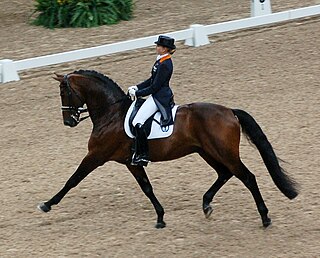
A Dutch Warmblood is a warmblood type of horse registered with the Koninklijk Warmbloed Paardenstamboek Nederland (Royal Warmblood Studbook of the Netherlands, which governs the breeding of competitive dressage and show jumping horses, as well as the show harness horse and Gelderlander, and a hunter studbook in North America. Developed through a breeding program that began in the 1960s, the Dutch are some of the most successful competition horses developed in postwar Europe.
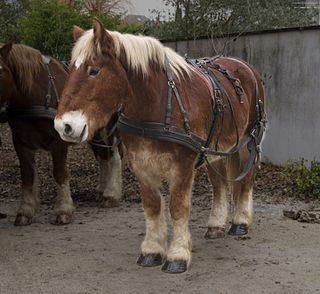
The Trait Breton is a French breed of draught horse. It originated in Brittany, in north-west France, from cross-breeding of local horses with various other breeds. It is strong and muscular, and often has a chestnut coat.

The Gelderlander is a Dutch breed of warmblood horse. It was bred in the province of Gelderland in the Netherlands as a carriage horse capable also of farm work. It declined in popularity in the mid-twentieth century. In 1965 it was one of the foundation breeds of the Dutch Warmblood or KWPN, the other being the heavier Groninger horse from the north. It is registered in a division of the Royal Dutch Warmblood Horse Studbook, which also has divisions for the Dutch Warmblood and for the Dutch Harness Horse.

The heavy warmbloods are a group of horse breeds primarily from continental Europe. The title includes the Ostfriesen and Alt-Oldenburger ("Old-Oldenburger"), Groningen, and similar horses from Silesia, Saxony-Thuringia, and Bavaria. Breeds like the Hungarian Nonius, Kladruber, and Cleveland Bay are also often classed as "heavy warmbloods." They are the ancestors of the modern warmbloods, and are typically bred by preservation groups to fit the pre-World War I model of the all-purpose utility horse. Unlike the registries of the sport horses that followed them, many heavy warmblood registries maintain closed or partly closed studbooks. However, external evaluation and performance testing of the breeding stock is still a key element in these registries. Many of the heavy warmbloods are selected primarily for family-friendly temperaments.

The Alt-Oldenburger and Ostfriesen are representatives of a group of horse breeds primarily from continental Europe called heavy warmbloods. The breed has two names because the same horse was bred in two regions in the most north-western part of Germany: East Frisia and the former grand duchy of Oldenburg. The name "Alt-Oldenburger" - alt meaning "old" - simply distinguishes this horse from its descendant, the modern Oldenburg, which is bred for sport.
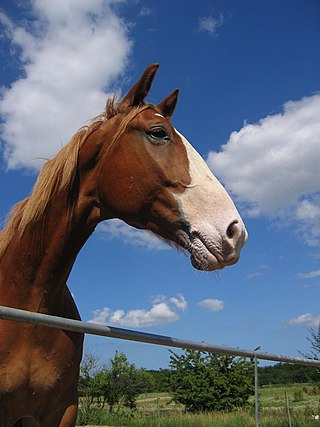
The Frederiksborger is Denmark's oldest horse breed. They were tremendously popular throughout the Renaissance and Baroque periods and were considered luxury items. Today, the breed is rare, but has a loyal following. Stallions and mares undergo studbook inspections before being allowed to breed. They are most often chestnut with white markings.

The Zweibrücker is a type of German warmblood horse bred in Rhineland-Palatinate and Saarland. Traditionally, the breeding of Zweibrücken was centered on the onetime Principal Stud of Zweibrücken but since 1977 has been under the jurisdiction of the Horse Breeders' Association of Rhineland-Palatinate-Saar (PRPS). The modern Zweibrücker is an elegant, large-framed, correct sport horse with powerful, elastic gaits suitable for dressage, show jumping, eventing and combined driving.
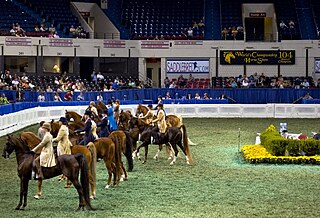
The World's Championship Horse Show, held at the Kentucky State Fairgrounds in Louisville, Kentucky, in Freedom Hall, is a large horse show that includes the American Saddlebred, Hackney pony, Dutch Harness Horse, and Standardbred breeds. It is usually held annually in late August, coinciding with the dates of the Kentucky State Fair and in the middle of the show season for the three breeds. Any horse or rider who wins there earns the title of World's Champion, and a second-place finish is identified with a Reserve World's Championship title. In addition to the WC and RWC titles, a horse can also earn the World's Grand Championship (WGC) or World's Championship of Champions (WCC) title. The winner of a championship class which requires a qualifier is given one of these titles.
The Baroque Pinto is a Dutch horse breed of Baroque type founded in the 1950s and 1960s, using the Friesian horse, Dutch Warmblood (KWPN), German Warmblood, and other European warmblood breeds for its foundation stock. Some consider it to be a type of Friesian cross or Friesian Sporthorse, while others consider it to be its own breed.





















